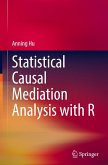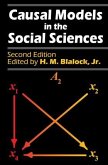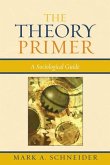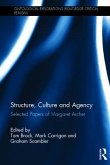- Gebundenes Buch
- Merkliste
- Auf die Merkliste
- Bewerten Bewerten
- Teilen
- Produkt teilen
- Produkterinnerung
- Produkterinnerung
This brief text for students in the social and behavioral sciences provides a formal introduction to the way theories are constructed, stated, tested, and connected together to form a scientific body of knowledge.
Andere Kunden interessierten sich auch für
![Statistical Causal Mediation Analysis with R Statistical Causal Mediation Analysis with R]() Anning HuStatistical Causal Mediation Analysis with R39,99 €
Anning HuStatistical Causal Mediation Analysis with R39,99 €![Causal Models in the Social Sciences Causal Models in the Social Sciences]() Causal Models in the Social Sciences170,99 €
Causal Models in the Social Sciences170,99 €![The Theory Primer The Theory Primer]() Mark A SchneiderThe Theory Primer162,99 €
Mark A SchneiderThe Theory Primer162,99 €![Structure, Culture and Agency Structure, Culture and Agency]() Tom BrockStructure, Culture and Agency210,99 €
Tom BrockStructure, Culture and Agency210,99 €![Causality and Causal Modelling in the Social Sciences Causality and Causal Modelling in the Social Sciences]() Federica RussoCausality and Causal Modelling in the Social Sciences104,99 €
Federica RussoCausality and Causal Modelling in the Social Sciences104,99 €![Causality and Causal Modelling in the Social Sciences Causality and Causal Modelling in the Social Sciences]() Federica RussoCausality and Causal Modelling in the Social Sciences104,99 €
Federica RussoCausality and Causal Modelling in the Social Sciences104,99 €![Norbert Elias and Empirical Research Norbert Elias and Empirical Research]() Norbert Elias and Empirical Research55,99 €
Norbert Elias and Empirical Research55,99 €-
-
-
This brief text for students in the social and behavioral sciences provides a formal introduction to the way theories are constructed, stated, tested, and connected together to form a scientific body of knowledge.
Hinweis: Dieser Artikel kann nur an eine deutsche Lieferadresse ausgeliefert werden.
Hinweis: Dieser Artikel kann nur an eine deutsche Lieferadresse ausgeliefert werden.
Produktdetails
- Produktdetails
- Verlag: Taylor & Francis
- Seitenzahl: 208
- Erscheinungstermin: 13. November 2017
- Englisch
- Abmessung: 229mm x 152mm x 13mm
- Gewicht: 449g
- ISBN-13: 9781138467989
- ISBN-10: 1138467987
- Artikelnr.: 57497508
- Herstellerkennzeichnung
- Libri GmbH
- Europaallee 1
- 36244 Bad Hersfeld
- gpsr@libri.de
- Verlag: Taylor & Francis
- Seitenzahl: 208
- Erscheinungstermin: 13. November 2017
- Englisch
- Abmessung: 229mm x 152mm x 13mm
- Gewicht: 449g
- ISBN-13: 9781138467989
- ISBN-10: 1138467987
- Artikelnr.: 57497508
- Herstellerkennzeichnung
- Libri GmbH
- Europaallee 1
- 36244 Bad Hersfeld
- gpsr@libri.de
Paul Davidson Reynolds has been the author or co-author of five books; seven edited collections; 42 research reports and monographs; 85 peer review journal articles and book chapters; eight data sets placed in public archives; and over two hundred presentations to professional and policy audiences. He served as the director of the Babson Research Conference from 1996 to 2000 and as co-director of the George Washington University-ICSB research conference from 2010 to 2012. In 2004 he received the annual Swedish International Award for Entrepreneurship and Small Business Research and in 2012 the Dedication to Entrepreneurship (Research) Award from the Academy of Management Entrepreneurship Division.
INTRODUCTION For What Should Scientific Knowledge Be Useful? Typologies,
Prediction and Explanation, Sense of Understanding, Control Theory How Does
a Concept or Statement Become Part of a Scientific Body of Knowledge?
Desirable Characteristics of Scientific Knowledge--Abstractness,
Intersubjectivity (Meaning), Intersubjectivity (Logical Rigor), Empirical
Relevance Summary and Conclusion 2. THE IDEA Kuhn Paradigms Example:
Freud's Theory of Personality Paradigms Examples: Heider's Balance Theory;
Two Conceptions Of Status Structures: Elitist and Pluralistic Paradigm
Variations Examples: Variations on the Freudian Conception of Personality;
Variations on Heider's Balance Theory Identifying Paradigms Conclusion 3.
CONCEPTS Definition of Concepts Abstract vs. Concrete Concepts Concept
Measurement Quantification of Concepts--The Nominal Level, The Ordinal
Level, The Interval Level, General Comments on Quantification 4. STATEMENTS
Existence Statements Relational Statements--Associational Statements,
Casual Statements, Deterministic and Probabilistic Statements Levels of
Abstraction Theoretical Statements Relation of Theoretical Statements to
Theory Relationship between Theoretical Statements and Empirical Data
Summary 5. FORMS OF THEORIES The Set-of-Laws Form Examples: The Iron Law Of
Oligarchy; The Laws of Operant Behavior; The Exercise of Influence in Small
Groups The Axiomatic Form Example: The Exercise of Influence in Small
Groups The Casual Process Form Examples: The Effect of First Impressions on
Cognitions; Creation of Oligarchies; Operant Behavior, Law II; The Exercise
Of Influence in Small Groups; Status Incongruence and Mental Health
Evaluation of the Three Forms of Theory Simulation or Model Building
Summary 6. TESTING THEORIES Abstract Statements and Concrete Research
Empirical Research and Confidence in Abstract Statements Statisical
Decision Procedures--Classical Statistical Inference; Should the Hypothesis
be Presented before the Data are examined? Changing Confidence in Theories
Comparing Theories Conclusion 7. STRATEGIES FOR DEVELOPING A SCIENTIFIC
BODY OF KNOWLEDGE Research-The-Theory Theory-Then-Research Comparison of
Strategies How to get a New Idea Composite Approach Research Methods
Conclusion 8. CONCLUSION Potential for a Social Science Potential for a
Social Science APPENDIX: STUDENT EXERCISES Comments Assignment 1: Empirical
Generalization and Empirical Support Assignment II: Explanation of an
Empirical Generalization Assignment III: Testing a Theory Assignment IV:
Application of Theories to Natural Phenomena REFERENCES AUTHOR INDEX
SUBJECT INDEX
Prediction and Explanation, Sense of Understanding, Control Theory How Does
a Concept or Statement Become Part of a Scientific Body of Knowledge?
Desirable Characteristics of Scientific Knowledge--Abstractness,
Intersubjectivity (Meaning), Intersubjectivity (Logical Rigor), Empirical
Relevance Summary and Conclusion 2. THE IDEA Kuhn Paradigms Example:
Freud's Theory of Personality Paradigms Examples: Heider's Balance Theory;
Two Conceptions Of Status Structures: Elitist and Pluralistic Paradigm
Variations Examples: Variations on the Freudian Conception of Personality;
Variations on Heider's Balance Theory Identifying Paradigms Conclusion 3.
CONCEPTS Definition of Concepts Abstract vs. Concrete Concepts Concept
Measurement Quantification of Concepts--The Nominal Level, The Ordinal
Level, The Interval Level, General Comments on Quantification 4. STATEMENTS
Existence Statements Relational Statements--Associational Statements,
Casual Statements, Deterministic and Probabilistic Statements Levels of
Abstraction Theoretical Statements Relation of Theoretical Statements to
Theory Relationship between Theoretical Statements and Empirical Data
Summary 5. FORMS OF THEORIES The Set-of-Laws Form Examples: The Iron Law Of
Oligarchy; The Laws of Operant Behavior; The Exercise of Influence in Small
Groups The Axiomatic Form Example: The Exercise of Influence in Small
Groups The Casual Process Form Examples: The Effect of First Impressions on
Cognitions; Creation of Oligarchies; Operant Behavior, Law II; The Exercise
Of Influence in Small Groups; Status Incongruence and Mental Health
Evaluation of the Three Forms of Theory Simulation or Model Building
Summary 6. TESTING THEORIES Abstract Statements and Concrete Research
Empirical Research and Confidence in Abstract Statements Statisical
Decision Procedures--Classical Statistical Inference; Should the Hypothesis
be Presented before the Data are examined? Changing Confidence in Theories
Comparing Theories Conclusion 7. STRATEGIES FOR DEVELOPING A SCIENTIFIC
BODY OF KNOWLEDGE Research-The-Theory Theory-Then-Research Comparison of
Strategies How to get a New Idea Composite Approach Research Methods
Conclusion 8. CONCLUSION Potential for a Social Science Potential for a
Social Science APPENDIX: STUDENT EXERCISES Comments Assignment 1: Empirical
Generalization and Empirical Support Assignment II: Explanation of an
Empirical Generalization Assignment III: Testing a Theory Assignment IV:
Application of Theories to Natural Phenomena REFERENCES AUTHOR INDEX
SUBJECT INDEX
INTRODUCTION For What Should Scientific Knowledge Be Useful? Typologies, Prediction and Explanation, Sense of Understanding, Control Theory How Does a Concept or Statement Become Part of a Scientific Body of Knowledge? Desirable Characteristics of Scientific Knowledge--Abstractness, Intersubjectivity (Meaning), Intersubjectivity (Logical Rigor), Empirical Relevance Summary and Conclusion 2. THE IDEA Kuhn Paradigms Example: Freud's Theory of Personality Paradigms Examples: Heider's Balance Theory; Two Conceptions Of Status Structures: Elitist and Pluralistic Paradigm Variations Examples: Variations on the Freudian Conception of Personality; Variations on Heider's Balance Theory Identifying Paradigms Conclusion 3. CONCEPTS Definition of Concepts Abstract vs. Concrete Concepts Concept Measurement Quantification of Concepts--The Nominal Level, The Ordinal Level, The Interval Level, General Comments on Quantification 4. STATEMENTS Existence Statements Relational Statements--Associational Statements, Casual Statements, Deterministic and Probabilistic Statements Levels of Abstraction Theoretical Statements Relation of Theoretical Statements to Theory Relationship between Theoretical Statements and Empirical Data Summary 5. FORMS OF THEORIES The Set-of-Laws Form Examples: The Iron Law Of Oligarchy; The Laws of Operant Behavior; The Exercise of Influence in Small Groups The Axiomatic Form Example: The Exercise of Influence in Small Groups The Casual Process Form Examples: The Effect of First Impressions on Cognitions; Creation of Oligarchies; Operant Behavior, Law II; The Exercise Of Influence in Small Groups; Status Incongruence and Mental Health Evaluation of the Three Forms of Theory Simulation or Model Building Summary 6. TESTING THEORIES Abstract Statements and Concrete Research Empirical Research and Confidence in Abstract Statements Statisical Decision Procedures--Classical Statistical Inference; Should the Hypothesis be Presented before the Data are examined? Changing Confidence in Theories Comparing Theories Conclusion 7. STRATEGIES FOR DEVELOPING A SCIENTIFIC BODY OF KNOWLEDGE Research-The-Theory Theory-Then-Research Comparison of Strategies How to get a New Idea Composite Approach Research Methods Conclusion 8. CONCLUSION Potential for a Social Science Potential for a Social Science APPENDIX: STUDENT EXERCISES Comments Assignment 1: Empirical Generalization and Empirical Support Assignment II: Explanation of an Empirical Generalization Assignment III: Testing a Theory Assignment IV: Application of Theories to Natural Phenomena REFERENCES AUTHOR INDEX SUBJECT INDEX
INTRODUCTION For What Should Scientific Knowledge Be Useful? Typologies,
Prediction and Explanation, Sense of Understanding, Control Theory How Does
a Concept or Statement Become Part of a Scientific Body of Knowledge?
Desirable Characteristics of Scientific Knowledge--Abstractness,
Intersubjectivity (Meaning), Intersubjectivity (Logical Rigor), Empirical
Relevance Summary and Conclusion 2. THE IDEA Kuhn Paradigms Example:
Freud's Theory of Personality Paradigms Examples: Heider's Balance Theory;
Two Conceptions Of Status Structures: Elitist and Pluralistic Paradigm
Variations Examples: Variations on the Freudian Conception of Personality;
Variations on Heider's Balance Theory Identifying Paradigms Conclusion 3.
CONCEPTS Definition of Concepts Abstract vs. Concrete Concepts Concept
Measurement Quantification of Concepts--The Nominal Level, The Ordinal
Level, The Interval Level, General Comments on Quantification 4. STATEMENTS
Existence Statements Relational Statements--Associational Statements,
Casual Statements, Deterministic and Probabilistic Statements Levels of
Abstraction Theoretical Statements Relation of Theoretical Statements to
Theory Relationship between Theoretical Statements and Empirical Data
Summary 5. FORMS OF THEORIES The Set-of-Laws Form Examples: The Iron Law Of
Oligarchy; The Laws of Operant Behavior; The Exercise of Influence in Small
Groups The Axiomatic Form Example: The Exercise of Influence in Small
Groups The Casual Process Form Examples: The Effect of First Impressions on
Cognitions; Creation of Oligarchies; Operant Behavior, Law II; The Exercise
Of Influence in Small Groups; Status Incongruence and Mental Health
Evaluation of the Three Forms of Theory Simulation or Model Building
Summary 6. TESTING THEORIES Abstract Statements and Concrete Research
Empirical Research and Confidence in Abstract Statements Statisical
Decision Procedures--Classical Statistical Inference; Should the Hypothesis
be Presented before the Data are examined? Changing Confidence in Theories
Comparing Theories Conclusion 7. STRATEGIES FOR DEVELOPING A SCIENTIFIC
BODY OF KNOWLEDGE Research-The-Theory Theory-Then-Research Comparison of
Strategies How to get a New Idea Composite Approach Research Methods
Conclusion 8. CONCLUSION Potential for a Social Science Potential for a
Social Science APPENDIX: STUDENT EXERCISES Comments Assignment 1: Empirical
Generalization and Empirical Support Assignment II: Explanation of an
Empirical Generalization Assignment III: Testing a Theory Assignment IV:
Application of Theories to Natural Phenomena REFERENCES AUTHOR INDEX
SUBJECT INDEX
Prediction and Explanation, Sense of Understanding, Control Theory How Does
a Concept or Statement Become Part of a Scientific Body of Knowledge?
Desirable Characteristics of Scientific Knowledge--Abstractness,
Intersubjectivity (Meaning), Intersubjectivity (Logical Rigor), Empirical
Relevance Summary and Conclusion 2. THE IDEA Kuhn Paradigms Example:
Freud's Theory of Personality Paradigms Examples: Heider's Balance Theory;
Two Conceptions Of Status Structures: Elitist and Pluralistic Paradigm
Variations Examples: Variations on the Freudian Conception of Personality;
Variations on Heider's Balance Theory Identifying Paradigms Conclusion 3.
CONCEPTS Definition of Concepts Abstract vs. Concrete Concepts Concept
Measurement Quantification of Concepts--The Nominal Level, The Ordinal
Level, The Interval Level, General Comments on Quantification 4. STATEMENTS
Existence Statements Relational Statements--Associational Statements,
Casual Statements, Deterministic and Probabilistic Statements Levels of
Abstraction Theoretical Statements Relation of Theoretical Statements to
Theory Relationship between Theoretical Statements and Empirical Data
Summary 5. FORMS OF THEORIES The Set-of-Laws Form Examples: The Iron Law Of
Oligarchy; The Laws of Operant Behavior; The Exercise of Influence in Small
Groups The Axiomatic Form Example: The Exercise of Influence in Small
Groups The Casual Process Form Examples: The Effect of First Impressions on
Cognitions; Creation of Oligarchies; Operant Behavior, Law II; The Exercise
Of Influence in Small Groups; Status Incongruence and Mental Health
Evaluation of the Three Forms of Theory Simulation or Model Building
Summary 6. TESTING THEORIES Abstract Statements and Concrete Research
Empirical Research and Confidence in Abstract Statements Statisical
Decision Procedures--Classical Statistical Inference; Should the Hypothesis
be Presented before the Data are examined? Changing Confidence in Theories
Comparing Theories Conclusion 7. STRATEGIES FOR DEVELOPING A SCIENTIFIC
BODY OF KNOWLEDGE Research-The-Theory Theory-Then-Research Comparison of
Strategies How to get a New Idea Composite Approach Research Methods
Conclusion 8. CONCLUSION Potential for a Social Science Potential for a
Social Science APPENDIX: STUDENT EXERCISES Comments Assignment 1: Empirical
Generalization and Empirical Support Assignment II: Explanation of an
Empirical Generalization Assignment III: Testing a Theory Assignment IV:
Application of Theories to Natural Phenomena REFERENCES AUTHOR INDEX
SUBJECT INDEX
INTRODUCTION For What Should Scientific Knowledge Be Useful? Typologies, Prediction and Explanation, Sense of Understanding, Control Theory How Does a Concept or Statement Become Part of a Scientific Body of Knowledge? Desirable Characteristics of Scientific Knowledge--Abstractness, Intersubjectivity (Meaning), Intersubjectivity (Logical Rigor), Empirical Relevance Summary and Conclusion 2. THE IDEA Kuhn Paradigms Example: Freud's Theory of Personality Paradigms Examples: Heider's Balance Theory; Two Conceptions Of Status Structures: Elitist and Pluralistic Paradigm Variations Examples: Variations on the Freudian Conception of Personality; Variations on Heider's Balance Theory Identifying Paradigms Conclusion 3. CONCEPTS Definition of Concepts Abstract vs. Concrete Concepts Concept Measurement Quantification of Concepts--The Nominal Level, The Ordinal Level, The Interval Level, General Comments on Quantification 4. STATEMENTS Existence Statements Relational Statements--Associational Statements, Casual Statements, Deterministic and Probabilistic Statements Levels of Abstraction Theoretical Statements Relation of Theoretical Statements to Theory Relationship between Theoretical Statements and Empirical Data Summary 5. FORMS OF THEORIES The Set-of-Laws Form Examples: The Iron Law Of Oligarchy; The Laws of Operant Behavior; The Exercise of Influence in Small Groups The Axiomatic Form Example: The Exercise of Influence in Small Groups The Casual Process Form Examples: The Effect of First Impressions on Cognitions; Creation of Oligarchies; Operant Behavior, Law II; The Exercise Of Influence in Small Groups; Status Incongruence and Mental Health Evaluation of the Three Forms of Theory Simulation or Model Building Summary 6. TESTING THEORIES Abstract Statements and Concrete Research Empirical Research and Confidence in Abstract Statements Statisical Decision Procedures--Classical Statistical Inference; Should the Hypothesis be Presented before the Data are examined? Changing Confidence in Theories Comparing Theories Conclusion 7. STRATEGIES FOR DEVELOPING A SCIENTIFIC BODY OF KNOWLEDGE Research-The-Theory Theory-Then-Research Comparison of Strategies How to get a New Idea Composite Approach Research Methods Conclusion 8. CONCLUSION Potential for a Social Science Potential for a Social Science APPENDIX: STUDENT EXERCISES Comments Assignment 1: Empirical Generalization and Empirical Support Assignment II: Explanation of an Empirical Generalization Assignment III: Testing a Theory Assignment IV: Application of Theories to Natural Phenomena REFERENCES AUTHOR INDEX SUBJECT INDEX









